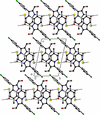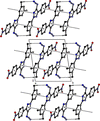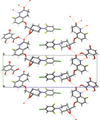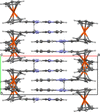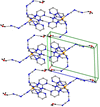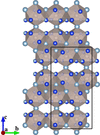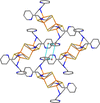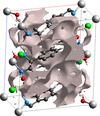issue contents
October 2023 issue

Cover illustration: Co-crystals of the anti-tuberculosis drug quabodepistat with 2,5-dihydrobenzoic acid proved to be far too small (typically 1.0 × 0.2 × 0.2 µm) for conventional X-ray structure analysis. They were, however, amenable to 3D electron diffraction (3D-ED). The crystals, which exhibit extensive hydrogen bonding, are monoclinic (P21), but twinned by pseudo-merohedry. See Sakamoto & Gato & [Acta Cryst. (2023). E78, 920–922].
research communications
Download citation


Download citation


The crystal structure of the title compound consists of discrete complexes in which the CoII cations are octahedrally coordinated and show strong pseudosymmetry.
CCDC reference: 2286746
Download citation


Download citation


In the crystal structure of the title compound, the cobalt cations are octahedrally coordinated by pairs of μ-1,1-bridging chloride anions and bridging pyridazine ligands and linked into chains propagating along the crystallographic b-axis direction.
CCDC reference: 2287781
Download citation


Download citation


The one-pot synthesis, crystal structure, Hirshfeld surface analysis, DFT and NBO study of a highly functionalized tetrahydropyridine are reported.
CCDC reference: 2290952
Download citation


Download citation


In the crystal of the title compound, C—H⋯O hydrogen bonds link the molecules, enclosing ![[R_{2}^{2}]](/e/issues/2023/10/00/wm5688/teximages/wm5688fi1.svg) (10) and
(10) and ![[R_{2}^{2}]](/e/issues/2023/10/00/wm5688/teximages/wm5688fi1.svg) (16) ring motifs, into layers almost parallel to the bc plane. The layers are further connected by π–π stacking interactions.
(16) ring motifs, into layers almost parallel to the bc plane. The layers are further connected by π–π stacking interactions.
CCDC reference: 2291603
Download citation


Download citation


In the crystal, pairs of molecules are linked by N—H⋯N hydrogen bonds, forming ![[R_{2}^{2}]](/e/issues/2023/10/00/vm2288/teximages/vm2288fi1.svg) (8) ring motifs. Dimers are connected by N—H⋯O hydrogen bonds, forming layers parallel to the (102) plane. These layers are connected by C—H⋯π and C=O⋯π interactions, consolidating the molecular packing.
(8) ring motifs. Dimers are connected by N—H⋯O hydrogen bonds, forming layers parallel to the (102) plane. These layers are connected by C—H⋯π and C=O⋯π interactions, consolidating the molecular packing.
CCDC reference: 2288949
Download citation


Download citation


The asymmetric unit of the title compound consists of two molecules differing to a small degree in their conformations. In the crystal, layers of molecules are connected by weak C—H⋯O hydrogen bonds and slipped π-stacking interactions.
CCDC reference: 2292321
Download citation


Download citation


In the salt 3-(4-fluorophenyl)-2-formyl-7-methylimidazo[1,2-a]pyridin-1-ium chloride monohydrate, water molecules form an ![[R_{2}^{4}]](/e/issues/2023/10/00/jy2034/teximages/jy2034fi1.svg) (8) motif parallel to the (100) plane by bonding with the chloride ions via O—H⋯Cl hydrogen bonds. The cations are connected along the b axis via N—H⋯O hydrogen bonds involving the O atoms of water molecules.
(8) motif parallel to the (100) plane by bonding with the chloride ions via O—H⋯Cl hydrogen bonds. The cations are connected along the b axis via N—H⋯O hydrogen bonds involving the O atoms of water molecules.
CCDC reference: 2289534
Download citation


Download citation


In the crystal, the molecules are connected by C—H⋯N hydrogen bonds and π–π stacking interactions, forming ribbons along the b-axis direction. Weak van der Waals interactions link these ribbons together, consolidating the crystal structure.
CCDC reference: 2293836
Download citation


Download citation


In the crystal of the title compound, molecules are linked to each other and solvent dimethylformamide molecules by N—H⋯S, N—H⋯O, C—H⋯O and C—H⋯S hydrogen bonds, forming a three dimensional network.
CCDC reference: 2294475
Download citation


Download citation


The previously unknown crystal structure of 2,6-dibromo-3,4,5-trimethoxybenzoic acid was determined employing state-of-the-art Hirshfeld atom refinement and the crystal packing was analysed using Hirshfeld surface analysis.
CCDC reference: 2281408
Download citation


Download citation


A co-crystal of quabodepistat and 2,5-dihydroxybenzoic acid was obtained and the crystal structure was solved from microcrystal electron diffraction (MicroED) data.
CCDC reference: 2205804
Download citation


Download citation


SiN2 was synthesized from the elements at 140 GPa in a laser-heated diamond anvil cell. Crystal-structure determination (single-crystal synchrotron X-ray data) revealed that the title compound crystallizes in the pyrite structure type (space group Pa![[\overline{3}]](/e/issues/2023/10/00/wm5694/teximages/wm5694fi1.svg) ).
).
CCDC reference: 2295150
Download citation


Download citation


The multi-step synthesis, characterization, and structural examination (single-crystal X-ray diffraction and Hirshfeld surface analysis) of 3-ferrocenyl-1-(pyridin-2-yl)-1H-pyrazol-5-amine (C18H16FeN4), are reported. The supramolecular characteristics, including π–π stacking and hydrogen bonding, are discussed, and a database exploration highlights the distinctive combination of molecular components.
CCDC reference: 2287368
Download citation


Download citation


Molecules of the title complex are centrosymmetric and the Fe—N bond lengths to the N atoms of the porphyrin ring indicate that the FeII atom is in the low-spin state.
CCDC reference: 975663
Download citation


Download citation


The solvothermal synthesis, crystal structure and Hirshfeld surface analysis of a new iron(II) complex containing dicyanamido and di(pyrimidin-2-yl)amine ligands are reported
CCDC reference: 2295696
Download citation


Download citation


A new solid-state inorganic compound, InPb2Cl5, was synthesized by melting InCl and PbCl2 in a vacuum-sealed quartz ampoule. Bulk InPb2Cl5 was separated from PbCl2 and characterized by single-crystal X-ray diffraction.
CCDC reference: 2294068
Download citation


Download citation


The crystal structures of five compounds in the Al–Ru–Si system with approximate compositions ∼Ru16(Al0.78Si0.22)47 (I), ∼Ru9(Al0.70Si0.30)32 (II), ∼Ru10(Al0.67Si0.33)41 (III), ∼Ru(Al0.57Si0.43)5 (IV) and ∼Ru2(Al0.46Si0.54)9 (V) are presented. Notably, the crystal structure of (I) can be related to that of a cubic rational crystalline approximant to an icosahedral quasicrystal through crystallographic shear and then unit-cell twinning.
Download citation


Download citation


A macrometallacyclic mercury(II) complex [((HgL2)(HgBr2))2], where HL = 2-{[(pyridin-2-yl)methyl]amino}ethane-1-thiol, was synthesized and characterized by single-crystal X-ray diffraction and Hirshfeld analysis.
CCDC reference: 2296007
Download citation


Download citation


The formation of a co-crystal sustained by π-type halogen bonds involving 1,4-diiodoperchlorobenzene and naphthalene is reported.
CCDC reference: 2291675
Download citation


Download citation


The title compound, a charge-neutral bis{5-(3,4-dimethoxyphenyl)-1,2,4-triazol-3-ato)-6-(pyrazol-1-yl)pyridine}iron(II) dimethanol dichloroform solvate, is a high-spin complex with a distorted pseudooctahedral coordination environment of the metal ion. Due to the tapered shape and polar nature, the molecules stack in one-dimensional columns that are bound by weak hydrogen bonds into layers, which, in turn, are arranged in a three-dimensional network without interlayer interactions below van der Waals radii.
CCDC reference: 2297496
Download citation


Download citation


The cation of the title compound exhibits point group symmetry ![[\overline{1}]](/e/issues/2023/10/00/wm5696/teximages/wm5696fi1.svg) , with the central NiII atom in a trans [N4O2] coordination environment.
, with the central NiII atom in a trans [N4O2] coordination environment.
CCDC reference: 2210342

 journal menu
journal menu

















